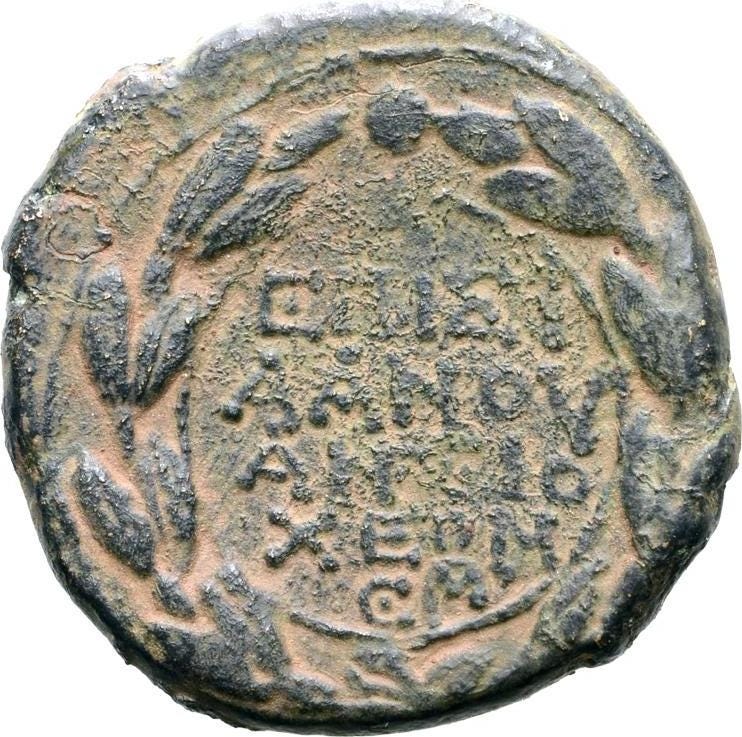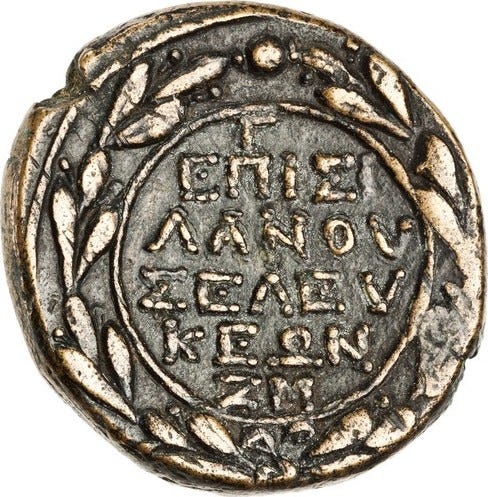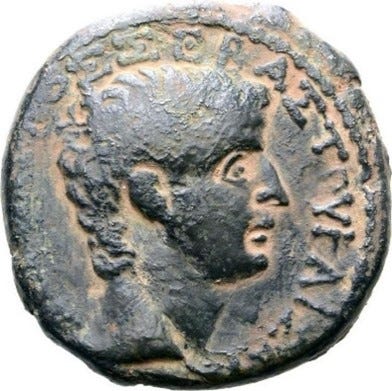(avg. read time: 5–11 mins.)
John begins his ministry in the 15th year of the reign of Tiberius (3:1)
In Luke 3, we return to information that will be helpful for determining the year in which Jesus was born, when Luke links the beginning of John the Baptist’s ministry (and, eventually, of Jesus’s) to all of these different leaders. Here Luke is following both biblical precedent and general historical precedent. Statements about when the word of the Lord came to the prophets often featured references to the reigns of certain rulers, sometimes even designating a year of that reign (Isa 6:1; Ezek 1:1–3; Amos 1:1; Zeph 1:1; Hag 1:1; Zech 1:1). However, the references to multiple rulers in prophetic prologues function to establish the span of a prophet’s ministry (Isa 1:1; Jer 1:1–3; Hos 1:1; Mic 1:1). But two of the best representatives of Greco-Roman historical work used references to multiple authority figures (Thucydides, Hist. 2.2) or multiple events (Polybius, Hist. 1.3) to establish a chronological framework. Luke only establishes precision with one of the references, as he probably did not have access to precise chronologies of the other figures to say in what year of their rule these events happened. We will treat these other five references as sub-sections, since they are all subsumed under this more direct and specific reference. At best, they serve as less specific confirmation on the timeline Luke establishes. But first, we must address the question of when the 15th year of Tiberius could be.
Occasionally, scholars suggest that Tiberius’s reign could be reckoned as beginning with a co-regency in 11/12 CE.1 The two pieces of evidence regularly cited to this effect are from Velleius Paterculus (Comp. Rom. Hist. 2.121) and Suetonius (Tib. 21.1), which refer to Tiberius having joint government with Augustus, as well as equal honor (at least in the case of Paterculus’s more flattering account). This dating is in turn consistent with Jesus being about 30 if he were born in 5/4 BCE (according to the conventional chronology) and began his ministry in 26/27 CE (depending on if Tiberius’s reign was reckoned by an accession or non-accession system).
This argument ultimately cannot explain why Luke would use such an unusual system. As we will see below, no one else reckoned Tiberius’s reign in this fashion.2 The virtue of such a system is simply its auspicious agreement with one of the traditional chronologies that dates Jesus’s death to 30 CE after a ministry of about 3 or 3 ½ years. But beyond this, nothing recommends it, even the sources that imply a position for Tiberius before Augustus’s death in which the former received equal honor and exercised equal power to the latter. Furthermore, Tiberius’s conduct after Augustus’s death implies that he was not recognized as emperor, nor would he have accepted such recognition, while Augustus was alive (Tacitus, Ann. 1.7–13; Suetonius, Tib. 24).
Tiberius’s first year is typically linked to the time after Augustus’s death in August of 14 CE. Velleius Paterculus, one of the authors cited for Tiberius’s co-regency, nevertheless refers to “the past 16 years” in his summary of Tiberius’s reign near the end of his work that he wrote in 30 CE (Comp. Rom. Hist. 2.126). Likewise, Suetonius, the other author adduced for this purpose, clearly reckons Tiberius’s reign to have ended in his 23rd year in 37 CE (Tib. 73.1). Others who reckoned Tiberius’s years in this fashion include Josephus (J.W. 2.168, 180; cf. Ant. 18.224), Tacitus (Dial. 17; Ann. 6.51), Theophilus of Antioch (Autol. 3.27), Clement of Alexandria (Strom. 1.21),3 Tertullian (Adv. Jud. 8), Hippolytus of Rome (Chron.), Cassius Dio (Rom. Hist. 58.28.5–6; cf. 56.30.5), Eusebius (Chron. [both translations, meaning Jerome agrees]), and the Chronography of 354.4 Mahieu also notes the following evidence:
– Egyptian papyri and ostraca render Tiberius’s first year as 14/15 AD.
– An inscription at Lapethus (in Cyprus) situates 16 November 29 AD in Tiberius’s 16th year. [IGR III no. 933]
– A coin from Antioch (in Syria) mentions both Tiberius’s first year and the year 45 of the Actian era (September 14/15 AD). A coin from Seleucia Pieria (in Syria) bears Tiberius’s third year and the year 47 of the Actian era (September 16/17 AD).
– An inscription near Massilia (modern Marseille, in Gaul) from the year 19 AD record Tiberius’s fifth year. [CIL XII no. 406]5


As such, all sources converge, using their different systems, somewhere in 14/15 CE.
Since Luke nowhere else indicates a divergent chronology, he is likely operating on a chronology that was generally assumed, including by Theophilus and anyone else in his audience. All these sources we have noted vary from each other in details, they come from a variety of areas, they rarely evince dependence on another source in this list for this information, and yet they agree with beginning Tiberius’s reign in either the year of or after Augustus’s death, rather than a few years prior, and this includes the two sources relied upon for the co-regency argument. We thus have cogent reasons for thinking that this chronological assumption of when Tiberius’s reign began was established early and shared widely from those early days. As we have noted already, there is much more significant variation of how long Augustus reigned, depending on if one counts from the death of Julius Caesar or the year thereafter (44/43 BCE), his victory at Actium (31 BCE), his conquest of Alexandria or the year thereafter (30/29 BCE), or his reception of the honorifics Augustus and Princeps from the Senate (27 BCE). By contrast, we see much less significant variation about the length of Tiberius’s reign and about when his reign began.
In terms of precision, a number of options are possible for one to consider the beginning of Tiberius’s reign. Alden Mosshammer summarizes the basic options well, “The first year of Tiberius could be backdated to 19 August AD 14 [from 17 September AD 14], to the Roman year beginning 1 January AD 14, postdated to 1 January AD 15, or synchronized with any of several civil calendars in the eastern empire that began in the fall.”6 It is not always clear when a given author is using one dating system as opposed to another, as Eusebius demonstrates that the same author could use different dating systems for different works, as he places Pilate’s installment as procurator to either the 12th (Hist. eccl. 1.9–10) or 13th (Chron. [both translations]) year of Tiberius, depending on which starting point he uses. But in both cases, the implied date of the 15th year of Tiberius is 28/29 CE. Jack Finegan shows how it is possible—based on the calendar, the use of an accession year or non-accession year system, and including the invalid co-regency system—to date the beginning of the 15th year as early as 26 and its end to as late as 30.7 But most likely, as John Meier demonstrates through his use of various calendars that Luke could have been assuming (Judean, Roman, or Antiochene/Syrian), the 15th year falls somewhere in the range of October of 27– December of 29 CE.8 All the cited methods overlap with the year 28 CE; the only question is if this was the start of Tiberius’s 15th year or the end of it. Given that Luke is most likely assuming a calendar his audience implicitly understands, and given Luke’s frequent references (especially in Acts) to Roman politics, it is most likely that his calendar for this purpose is Roman, which would eliminate any portion of 27 CE from consideration. That leaves us with the year in question being either 28 or 29 CE.9
Pontius Pilate is governor of Judea at this time (3:1)
As noted above, Pilate began his tenure in Judea in 26 CE. He was recalled in late 36 or early 37 CE after what Josephus describes as a 10-year tenure (Ant. 18.89). Josephus reports that Pilate was supposed to travel to Rome to be judged by Tiberius, but before he could make it to Rome, Tiberius was dead (Ant. 18.89). This range of dates seems basically secure, but it provides much less specificity than the 15th year of Tiberius.
Herod (Antipas) is the tetrarch of Galilee at this time (3:1)
(Herod) Philip is the tetrarch of Iturea and Trachonitis at this time (3:1)
These references provide even less specificity than the one to Pilate. We have already noted significant ambiguities in chronicling both of these figures. But regardless of the dating schema, any theory of the date of Jesus’s baptism fits here. The information is relevant, but not especially helpful or specific enough.
Lysanias is the tetrarch of Abilene at this time (3:1)
Of all the references in the opening of Luke 3, this one is the most perplexing. It must have been clear to Luke’s audience who this person was and when his tenure was, but it is no longer as clear to us. In fact, scholars tend to wonder why Luke bothers to mention him at all. He appears to be the least significant figure and his realm in no way intersects with the ministry of Jesus. We can say that a Lysanias (perhaps part of a dynasty) had his reign over Abilene/Abila end in March of 37 CE, when his tetrarchy was designated for Herod Agrippa I (Josephus, Ant. 18.237), although Josephus indicates that it was not given until the reign of Claudius (Ant. 19.275; J.W. 2.215). Claudius also bestowed Abila, which was described as the tetrarchy of Lysanias, to Herod Agrippa II (Ant. 20.138). In addition, there is a temple inscription from Abila (CIG no. 4521) that refers to one Nymphaios, a freedman of Lysanias the tetrarch of Abila, which has been dated to between 14 and 29 CE. Both Lysaniases of the inscription and Luke may be the same, but we simply cannot say with any significant degree of probability.
John the Baptist is operating during the high priesthood of Annas and Caiaphas (3:2)
The last leaders referenced are Annas and Caiaphas, both of whom will play important roles in Jesus’s execution (at least, Annas does in John, while Caiaphas, even when not named, is important in all). It is peculiar to refer to a high priesthood of two individuals, not least since it is not as if these two tenures ended and began in the same year, respectively. But Annas (or Ananus, as Josephus calls him) was a special fellow, a man who acted as a Godfather figure with the high priesthood. He was appointed to the high priesthood by Quirinius in 6 CE and was later deposed by Valerius Gratus in favor of Ishmael ben Phabi (Josephus, Ant. 18.26, 34). But he remained influential when Eleazar, his son, became high priest from 16–17 CE. After another brief tenure by Simon ben Camithus, Annas’s family returned to power when his son-in-law, Caiaphas, was appointed high priest in 18 CE (Ant. 18.35) and remained in that position until Passover of 36/37 CE (Ant. 18.95). Caiaphas was then replaced by Annas’s son Jonathan (36 and/or 37 CE), who was replaced by his brother Theophilus (37–41 CE), who was succeeded, after an intervening high priest, by his brother Matthias (43 CE). The dynasty ended with the son who shared his name (Ananus II) being appointed briefly in 62/63 CE, during which he oversaw the execution of Jesus’s brother James (Ant. 20.197–203), and who later acted as a leader of the Judean Revolt. Considering that high priests at this time were more often appointed by the rulers, rather than by simple succession (Josephus makes many references to such actions),10 and several different leaders were involved in the appointments of his family, Annas would have needed to be a skillful, powerful, and corrupt politician to retain power for so long. It is perhaps in allusion to this power behind the scenes that Luke references him alongside Caiaphas, not because they were high priest at the same time. It is Caiaphas who is the official high priest.
Summary
All of these figures do overlap—or, in the case of Lysanias, we at least suppose that they overlap—with any proposed 15th year of Tiberius. As writers from the first to fourth centuries agree in general terms about placing the beginning of Tiberius’s reign in either 14 or 15 CE, we can be reasonably confident in what year they would place the 15th year of Tiberius. And since Luke gives no indication that he is following a unique reckoning, we can also be reasonably confident that he follows the same general reckoning, although it is less clear if he is using a Jewish, Syrian (if that is where he writes from), or (as I am inclined to think) Roman calendar. In any case, it is most likely that the 15th year of Tiberius is 28 or 29 CE.
See the discussion of the possibilities in Bock, Luke 1:1–9:50, 910–13.
We do know that emperors marked their tribunician years, but not any years of supposed co-regency.
He does say that some give Tiberius 26 years and some change for his reign, rather than 22 years, but he also notes that some extend Augustus’s reign to 46 years. He references this other schema for completeness, but clearly uses the first schema for his own chronology. Furthermore, even by this argument, if the 26+ years was reckoned from co-regency, then Tiberius would have reigned for another 12 years after his 15th year until he died in his 27th year. This would then place his death in 38/39 CE, which we cannot square with any other source.
The last source is available online at: http://www.tertullian.org/fathers/chronography_of_354_15_liber_generationis.htm. This portion of the Chronography draws from Hippolytus.
Mahieu, Herod the Great, 458.
Mosshammer, Easter Computus, 324.
Finegan, Handbook, 331–41.
John P. Meier, A Marginal Jew: Rethinking the Historical Jesus, vol. 1: The Roots of the Problem and Person (New York: Doubleday, 1991), 384–86. Cf. Mosshammer, Easter Computus, 324–25.
Further confirmation of these dates may appear in John 2:20, with its reference to it being 46 years since the temple’s construction at the first Passover of Jesus’s ministry. This work was completed in 19/18 BCE (Ant. 15.380–425). As there is only one celebration marking this construction (15.421–423), it is reasonable to think that both the temple itself and the enclosures were completed around the same time, and so there are not two potential dates to reckon from. This would place this Passover after Jesus’s baptism in either Nisan, 29 or Nisan, 30 CE. However, I have not addressed this in-depth because my focus has been on Matthew and Luke and there is enough controversy about this chronological note that it would take me too far afield. For more, see Mahieu, Herod the Great, 147–65, 465–68; Steinmann, “Reign,” 18.
In the Roman era: Ant. 14.72–73, 143–144; 15.22, 39–41, 56, 322; 17.78, 164–167, 339; 18.26, 34–35. 95; 19.313–316; 20.16, 103, 179, 196–197, 203, 223. Also note J.W. 4.147–150.




